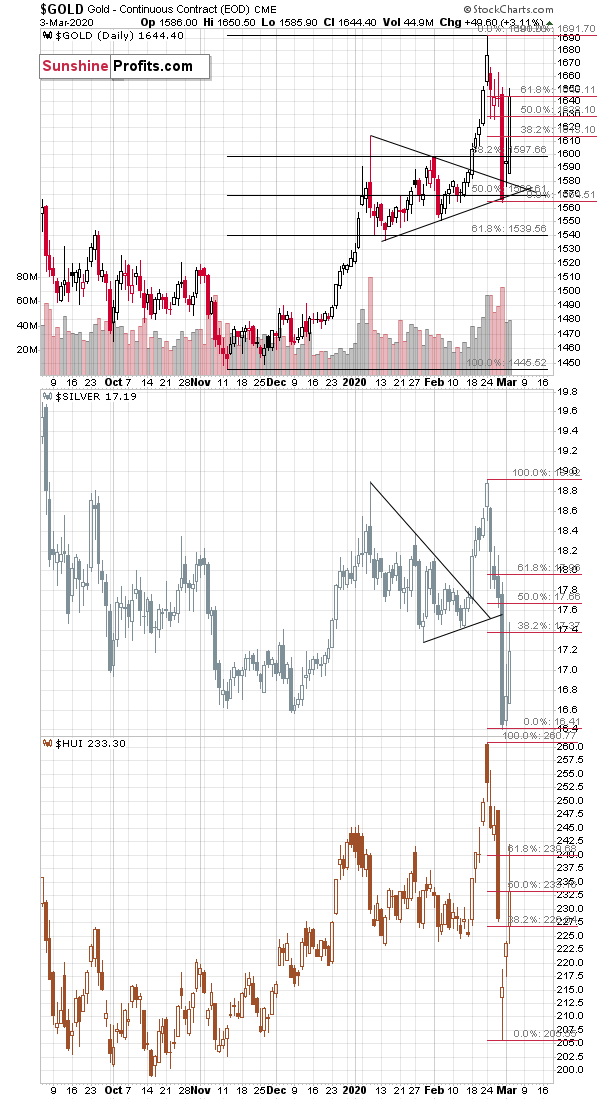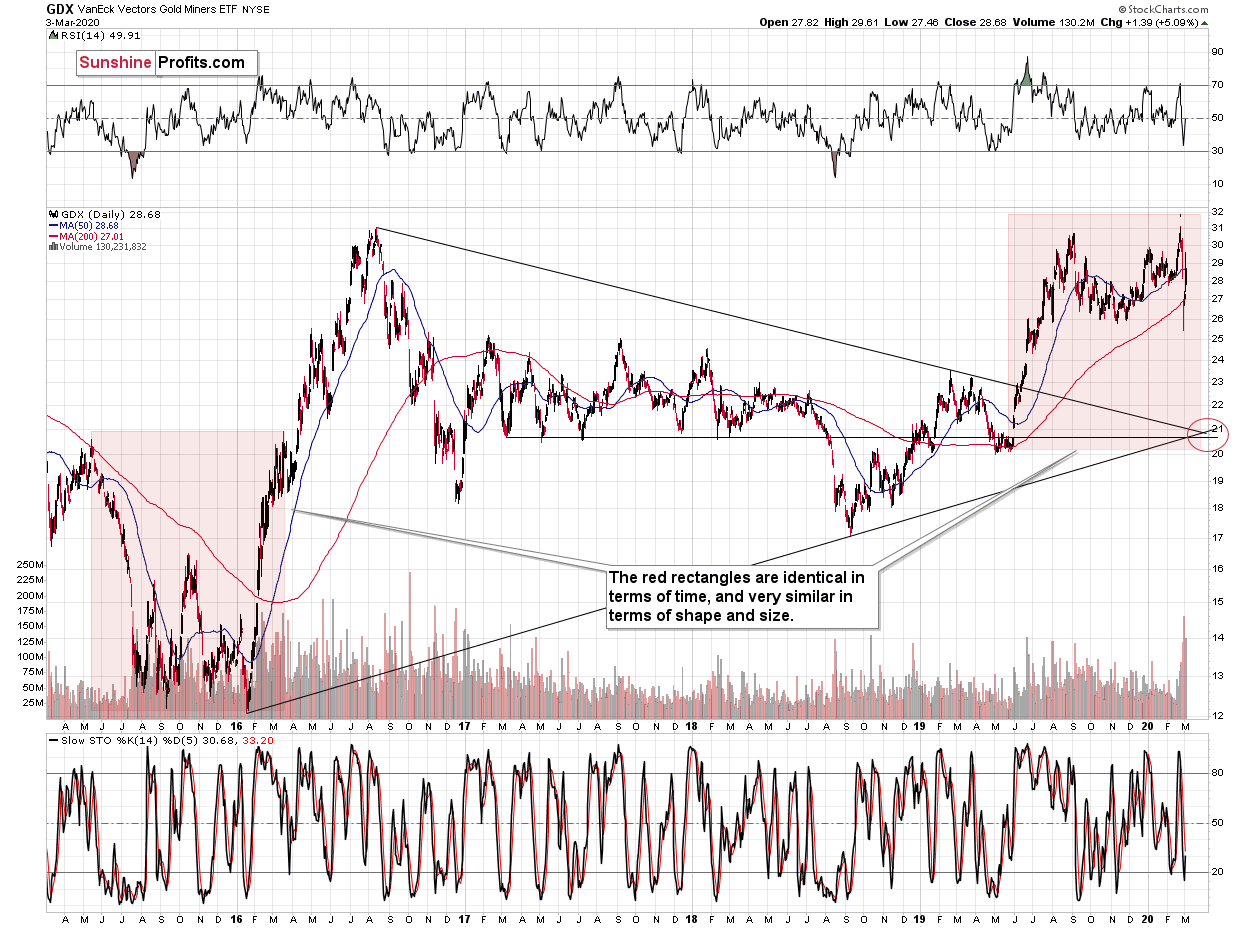Briefly: in our opinion, full speculative short positions (250% of the regular position size) in gold, silver, and mining stocks are justified from the risk/reward point of view at the moment of publishing this Alert.
It was only yesterday (and Monday), when we emphasized that it seems that it's 2008 all over again, and that the interest rate cuts as well as possibility of QE4 are not likely to prevent markets from declining. The next regular interest rate decision is on March 18, but the Fed decided to cut the rates by 0.5% yesterday in a surprising move. And... stocks declined (and we profited both on their move higher in anticipation of that cut, and also on the intraday decline in its aftermath in our Stock Trading Alerts), just like they did in 2008, when the rates were cut.
Yes, a rate cut, as a response to the coronavirus threat, is a theoretically bullish development, as it's positive for the economy in the short run, but it seems that the market viewed this decision as an act of desperation, and a confirmation that things might be much worse than they are being reported. This is a very dangerous kind of reaction, because the fact that the market declined, only reinforced the belief that the Fed can't stop a move down with lower rates. At least not before the market declines a lot.
Markets are forward-looking, which means that if people expect lower prices, they will sell right away, at prices that they still view as relatively high. It really does look like the 2008 decline.
So why did gold rally so much, yesterday? Doesn't that invalidate the analogy to 2008?
First of all, did gold really show a lot of bullishness yesterday? The rates were just cut by 0.5% in a surprising move, and gold is not at new highs, while miners reversed a large part of their gains before the closing bell.
Second, a single day event rarely invalidates or confirms anything. Quick moves can be accidental, or based on extremely short-term trends that are predicted using other means.
Third, it was not just a decrease in the interest rates. It was a surprising decrease in the interest rates. Gold, and the rest of the precious metals sector seems to have reacted not as much to the rates themselves, but to the surprise. Investors looked for safe haven, and they found it in gold. But, just as such rallies didn't last long in 2008, they are unlikely to last for long this year.
The Fedwatch tool didn't update yet after yesterday's decision from the Fed, which means that we don't know what kind of probabilities the market is assigning to further rate cuts this month (and how big they are likely to be).
However, we know that since the Fed cut the rates and surprised the market now, it has one fewer surprise-ace up its sleeve. This suggests that as the prices decline, it will take longer time, before another surprising move takes place (note: it's just likely that it works this way, it's far from certain - the Fed could have so many surprise-aces up its sleeve that using one now doesn't change much). This means that perhaps one of the corrective upswings that was supposed to happen in the future, has already happened in a surprising manner yesterday, and the decline that follows is likely to move lower in straighter fashion.
Yesterday's PMs Moves Examined
Gold corrected about 61.8% of the preceding decline.
Gold stocks corrected about 61.8% of the preceding decline, but ended the day at the 50% Fibonacci retracement.
Silver initially corrected a bit above 38.2% of the preceding decline, but wasn't able to hold this level, and ended the day visibly below this retracement.
These are all classic levels to which prices can retrace (correct) during a move without changing the trend. We saw the most strength in gold, and the least in silver, which is business-as-usual - that's what's been taking place in the previous days as well.
The point is that nothing particularly exceptional happened. Yes, the volatility was big, but it was in tune with what we saw previously. Volatile declines could be corrected with volatile rallies. And they can then be followed by additional volatile declines. Predicting that gold ended its decline just because we saw a 61.8% correction (and smaller moves in miners and silver) is likely a mistake.
Another indication that the upswing was a relatively normal part of the bigger decline comes from the GDX ETF.
The mid-2016 decline started from very similar levels, and after GDX dropped to about $25, it rallied approximately to its 50-day moving average, which was at about $28 at that time. Approximately the same thing took place today. The GDX jumped from about $25 to its 50-day moving average (GDX closed at it yesterday) and it was relatively close to $28. Back in 2016, the decline then resumed after a few weeks of sideways trading. The volatility is bigger this time, so we might not have to wait that long before the decline returns and miners move to new yearly lows.
Summary
Summing up, the 2020 top in the precious metals market is most likely in. Gold declined on record-breaking volume, while silver and miners plunged to new yearly lows - and it happened even before the USD's rally resumed. The outlook for the following months is extremely bearish, and the analogy to 2008 is very strong, also in terms of the likely interest rate moves. The PMs reaction to yesterday's surprising rate cut doesn't invalidate the above.
The profits on our big short position in the precious metals market are already sizable, but they are likely to become enormous in the following weeks.
As always, we'll keep you - our subscribers - informed.
To summarize:
Trading capital (supplementary part of the portfolio; our opinion): Full speculative short positions (250% of the full position) in gold, silver, and mining stocks are justified from the risk/reward perspective with the following stop-loss orders and binding exit profit-take price levels:
- Gold futures: profit-take exit price: $1,422; stop-loss: $1,712; initial target price for the DGLD ETN: $33.30; stop-loss for the DGLD ETN: $19.88
- Silver futures: profit-take exit price: $14.63; stop-loss: none (if gold moved to $1,712, we would view silver positions as no longer valid); initial target price for the DSLV ETN: $26.10; stop-loss for the DSLV ETN: none (if gold moved to $1,712 we would view silver positions as no longer valid)
- Mining stocks (price levels for the GDX ETF): profit-take exit price: $20.22; stop-loss: $30.52; initial target price for the DUST ETF: $11.29; stop-loss for the DUST ETF $4.35
In case one wants to bet on junior mining stocks' prices, here are the stop-loss details and target prices:
- GDXJ ETF: profit-take exit price: $28.32; stop-loss: $43.52
- JDST ETF: profit-take exit price: $20.97; stop-loss: $7.88
Long-term capital (core part of the portfolio; our opinion): No positions (in other words: cash)
Insurance capital (core part of the portfolio; our opinion): Full position
Whether you already subscribed or not, we encourage you to find out how to make the most of our alerts and read our replies to the most common alert-and-gold-trading-related-questions.
Please note that the in the trading section we describe the situation for the day that the alert is posted. In other words, it we are writing about a speculative position, it means that it is up-to-date on the day it was posted. We are also featuring the initial target prices, so that you can decide whether keeping a position on a given day is something that is in tune with your approach (some moves are too small for medium-term traders and some might appear too big for day-traders).
Plus, you might want to read why our stop-loss orders are usually relatively far from the current price.
Please note that a full position doesn't mean using all of the capital for a given trade. You will find details on our thoughts on gold portfolio structuring in the Key Insights section on our website.
As a reminder - "initial target price" means exactly that - an "initial" one, it's not a price level at which we suggest closing positions. If this becomes the case (like it did in the previous trade) we will refer to these levels as levels of exit orders (exactly as we've done previously). Stop-loss levels, however, are naturally not "initial", but something that, in our opinion, might be entered as an order.
Since it is impossible to synchronize target prices and stop-loss levels for all the ETFs and ETNs with the main markets that we provide these levels for (gold, silver and mining stocks - the GDX ETF), the stop-loss levels and target prices for other ETNs and ETF (among other: UGLD, DGLD, USLV, DSLV, NUGT, DUST, JNUG, JDST) are provided as supplementary, and not as "final". This means that if a stop-loss or a target level is reached for any of the "additional instruments" (DGLD for instance), but not for the "main instrument" (gold in this case), we will view positions in both gold and DGLD as still open and the stop-loss for DGLD would have to be moved lower. On the other hand, if gold moves to a stop-loss level but DGLD doesn't, then we will view both positions (in gold and DGLD) as closed. In other words, since it's not possible to be 100% certain that each related instrument moves to a given level when the underlying instrument does, we can't provide levels that would be binding. The levels that we do provide are our best estimate of the levels that will correspond to the levels in the underlying assets, but it will be the underlying assets that one will need to focus on regarding the signs pointing to closing a given position or keeping it open. We might adjust the levels in the "additional instruments" without adjusting the levels in the "main instruments", which will simply mean that we have improved our estimation of these levels, not that we changed our outlook on the markets. We are already working on a tool that would update these levels on a daily basis for the most popular ETFs, ETNs and individual mining stocks.
Our preferred ways to invest in and to trade gold along with the reasoning can be found in the how to buy gold section. Additionally, our preferred ETFs and ETNs can be found in our Gold & Silver ETF Ranking.
As a reminder, Gold & Silver Trading Alerts are posted before or on each trading day (we usually post them before the opening bell, but we don't promise doing that each day). If there's anything urgent, we will send you an additional small alert before posting the main one.
Thank you.
Sincerely,
Przemyslaw Radomski, CFA
Editor-in-chief, Gold & Silver Fund Manager





